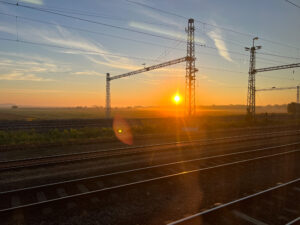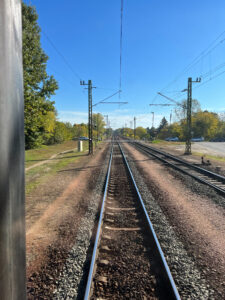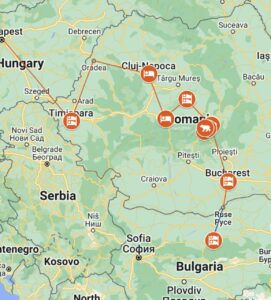Near the end of my stay in Romania, I’d been in Europe for 3 months, and I could tell how much I’d changed. Though I wasn’t exercising in a gym the way I did back home, I was physically stronger from carrying over 50 pounds of luggage every day and from the miles I spent walking. I had tan lines for the first time in my life, which is to say that I was a slightly darker shade of translucent than I usually am. I felt less anxious than I had since the pandemic started two and a half years earlier. But the change that mattered most to me was that I was writing.
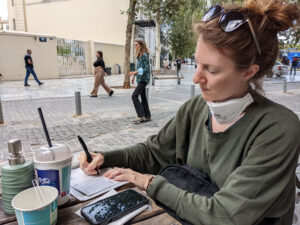
In college, I double majored in Literary Arts (fiction writing) and English Literature, and I got honors in Literary Arts for writing a book manuscript as a thesis. I went to graduate school for my MFA in Creative Nonfiction writing. I loved writing enough to devote my future (and an amount of student loans we won’t speak about) to it. I started teaching high school after graduating because it seemed like the obvious and sensible path for a writer to have a reliable salary. Plus, I genuinely loved teaching—I still do. I envisioned writing in cute coffee shops after work each day and on months-long vacations each summer break. Of course, the reality of teaching high school English is that there is no time whatsoever to write (or at least this is true for the first few years). For every moment that I wasn’t actively teaching or doing another supervising duty related to my job, I was making lesson plans or grading papers. During the summers, I worked jobs teaching at summer schools and camps because I didn’t make enough money to have an actual vacation.
After a couple years teaching high school, I took a job as an academic advisor at Tulane University because I thought it would be a job where my work wouldn’t come home with me at night so I could finally start writing again. In theory this would have worked except that the job paid so little at first that I had to tutor multiple students and do additional editing jobs every evening to pay my rent. When the university finally gave all staff a small raise, I was able to quit the side hustles…and then covid arrived, and suddenly our workload tripled overnight. By the time I quit my job to go on my trip, it had been 7 years since I finished graduate school and just as long since I’d written with any regularity. I’d published a handful of essays during those years, but I hadn’t produced a fraction of what I’d wanted, and it nagged at me constantly. I felt like I was squandering what felt like my purpose.
And then suddenly after I started traveling, I was writing. I’d had a blog for years before I started my trip, but I knew I wanted to write more frequently while I was traveling. My brother-in-law helped me set up my new website beforehand, and I posted the first trip-entry a few weeks into the journey. After that, I felt insatiable. I wrote frantically as if the memories would float away if I didn’t capture them on paper fast enough. I wrote by hand in a journal every day, then every week or so, I crafted a new blog post to share. It never felt boring to me. I was traveling too fast to post my blogs in real time, and that’s why I’m still posting them now. With the aid of a million photos, a small stack of travel journals, and my creepy memory, I get to re-live it all a second time with every new blog post I write.

In addition to the travel writing, something more delicate and magical started to happen. Months before I started traveling, I had the first hint of an idea for a fiction story. Typically, such ideas fizzle out, but this one didn’t. Before the sun rose one morning in October, I got on a nearly-empty train in Sibiu, Romania, heading to Cluj-Napoca, and I pulled out my computer and started writing a story. I was so engrossed in it that I nearly missed my stop 4 hours later and had to scramble my belongings up and dart off the train. I rushed to my Airbnb as fast as I could so I could sit down and keep writing before the idea got away. Then I spent the next day sitting in the Airbnb writing. And then I kept writing. And then a little over a month later, I’d written 50,000 words. There was a world alive in my mind that made every moment feel like possibility, like I was doing what I was supposed to be doing, like my trip was far more than a vacation to a bunch of neat places and was, in fact, a life-altering experience (which feels cliché to write but also feels true). The possibilities for my future felt different. Aspirations that had previously felt like far-fetched dreams felt within my grasp. Every new place I visited provided me with more inspiration.
In Cluj-Napoca, I mostly sat inside and wrote. I emerged for delicious meals at international restaurants and to climb the hill near Central Park for a view of the fall colors in the city, then I went back to my Airbnb and wrote more. Two days later, I got on another train to head to my final Romanian city—Timisoara. Every city I’d visited in Romania other than Bucharest had been in the region of Transylvania, and I was sad to leave what felt like a magical land that had filled me with wonder and inspiration.
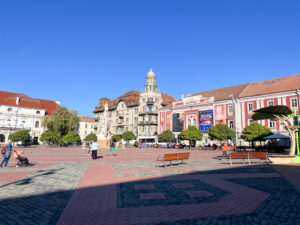


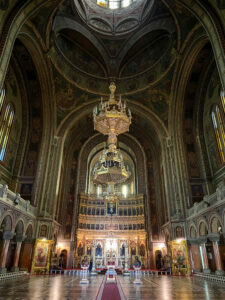
Timisoara probably receives the least tourists of the Romanian cities I visited, so I wasn’t sure what to expect. Now that I’ve visited, I have no idea why more people aren’t flocking there, but I strongly suspect that it won’t be long before they start to. I arrived at night and took an Uber to my hostel. Romania is a very safe country, but it’s always a little disconcerting to try navigating a new place alone in the dark as a female. When I couldn’t figure out how to access my hostel’s entrance, my Uber driver helped me carry my bags to the gate, refused to leave me alone in the dark, waited until I called the front desk, and made sure I got inside. Despite how prone I am to anxiety and how cautious I generally encourage people to be, traveling has taught me again and again that people are generally good.
The hostel was small, like staying in someone’s house. I had reserved the only private room there, and the other guests (nearly all guys in their young-mid-twenties) thought I must be rich to stay in the private room. In reality, the room cost $22. There was a communal atmosphere, and most of the guests walked together to the grocery store to buy ingredients for dinner. Even though I’d already eaten, I couldn’t refuse when they knocked on my door to invite me. Then when I was tired of being social, I retreated to my room to write.


Timisoara is in the region of Timis in Western Romania, a different region of Romania than I’d been to yet—far from the mountains and magic of Transylvania but full of a different kind of charm. Timisoara is full of parks, green spaces, and gorgeous squares with the kind of grand buildings that demands to be marveled at. It’s often called “Little Vienna” because of its stunning and diverse architecture—a colorful mix of Baroque, Neoclassicism, and Art Nouveau. The beauty here felt almost disconcerting because it was nearly devoid of all people. It felt like a place I was imagining–otherwise people would be crowding every square and filling every seat at the empty outdoor restaurant tables. The city felt surprisingly cosmopolitan and progressive for its size, and there are a ton of theaters, galleries, and festivals year-round. It was the second city in the world (after New York City) to be lit by electric streetlamps, and they are very proud of this fact. I spent two nights there, mostly wandering into bookstores and cafes and admiring the mix of modernity and history.
Timisoara was set to be one of the European Capitals of Culture in 2021, but it was delayed because of the pandemic to this year—2023. (Read more about what it means to be a Capital of Culture in my post about Plovdiv, Bulgaria.) I visited near the end of 2022, and it was very neat to see a place that is right on the brink of becoming a destination people seek out.



The reason most visitors know about Timisoara is because it was the city where the Romanian Revolution started in 1989 before spreading throughout the whole country and finally culminating in the death of the dictator, Nicolae Ceausescu (which I wrote about in this blog post). I went to the new Revolution Museum in Timisoara. It was small, and I was the only guest there, but they’ve done a great job with it. It was very moving to be there alone imagining what the Romanian people experienced just 3 decades ago.
On my departure day, I woke up before the sun rose again and split a cab with another hostel guest to the train station. I’d been in Romania for two weeks traveling by train throughout the country, and I felt sad to leave. I remembered how anxious I felt before visiting and how I considered cutting Romania from my trip entirely because of the heightened tension between Ukraine and Russia. As I left, it was hard to imagine how different my trip would have felt without Romania being part of it.
There wasn’t a very convenient or direct way to my next destination, Zagreb, Croatia. I had to take a train up to Budapest and then catch a bus there down to Zagreb. It was what some people might objectively consider a long day of travel, but by that point in my trip, no train or bus ride that fit easily into a single day felt particularly long. In Budapest, I had to take the metro from my arrival station to a different station across town where the bus terminal was, and it felt like months and months since Michael had met me there on the sidewalk to join me for our shared portion of the trip. I finally made it to my bus, and the sun set as I rode back into the Balkans.
